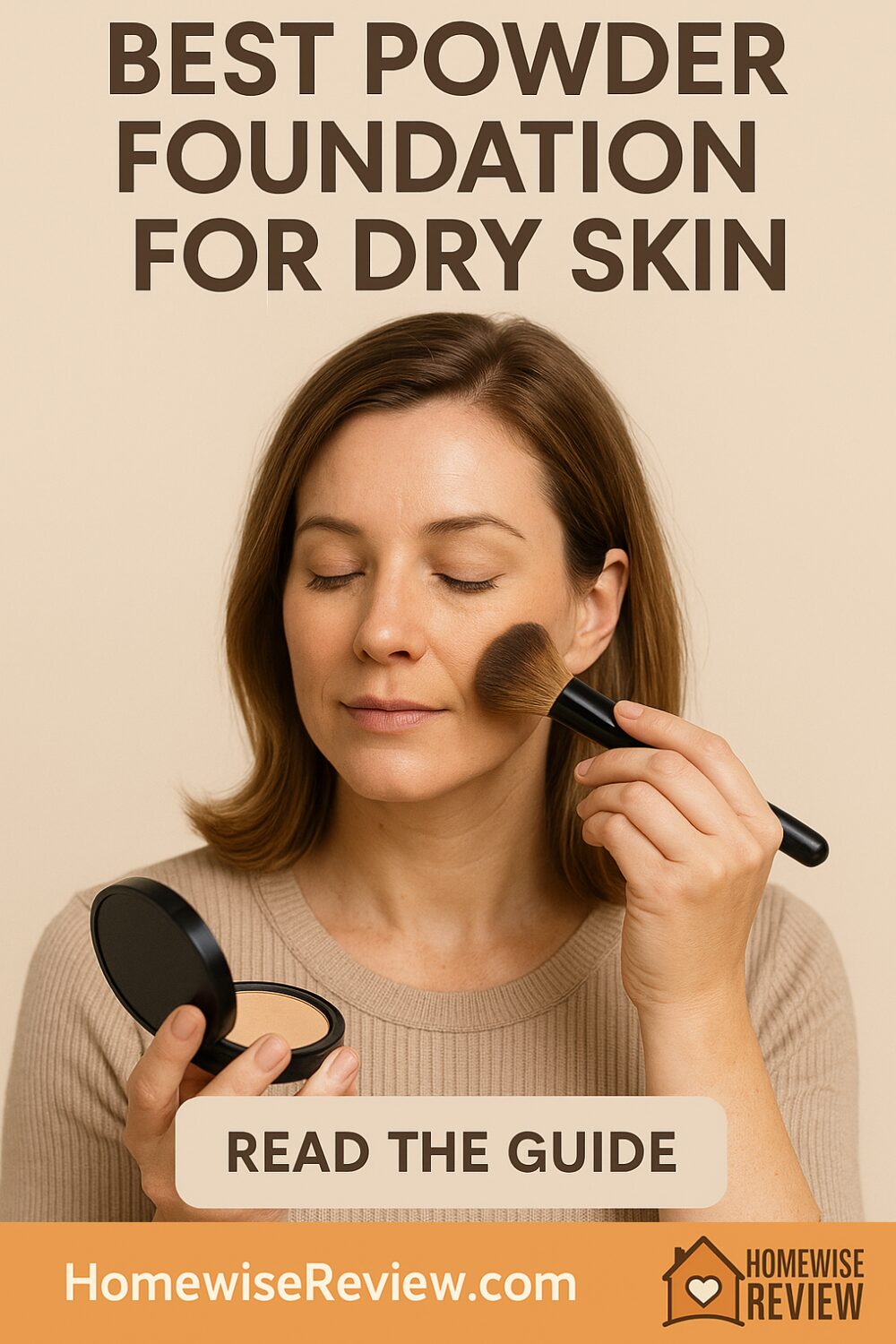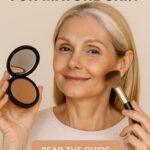
Soft coverage that smooths, not flakes.
Powder foundation has a reputation for looking dusty on dry skin, but the right formula can be a quiet miracle. Micro-fine minerals and modern binders melt into moisturizer, blur texture, and even out tone without grabbing onto flakes. If you love a fast, mess-free base or want a portable option for touch-ups, you do not have to avoid powder. You just need a satin or natural finish, skin-friendly binders, and a smart prep routine. This guide explains what to look for, how to apply powder so it reads like skin, and four excellent picks that keep dry complexions soft and comfortable from morning to night.
Why this matters
Dry skin lacks surface lipids and often shows micro-texture that traditional mattifying powders exaggerate. Talc-heavy or oil-stripping formulas soak up the little moisture you have, which highlights fine lines and clingy spots. On the flip side, modern powder foundations use emollient binders, amino-acid coated pigments, and light-reflecting minerals that glide over moisturizer instead of fighting it. Finish matters just as much as ingredients. A satin or soft-luminous finish mimics healthy skin, while flat matte can read chalky on cheeks that already run dry. Shade undertone also influences the result. Slightly neutral or olive-balanced tones usually look more skin-like than warm oranges or very cool pinks, which can emphasize redness or uneven tone. Get formula, finish, and undertone right, then pair them with a hydrating base and the correct tool, and you will see why powder can be the easiest low-maintenance base for dry skin.
Quick Picks + Comparison
| Pick | Why it is great | Finish / Format | Best for |
|---|---|---|---|
| bareMinerals Original Loose Mineral Foundation SPF 15 | Classic mineral glow that fuses with moisturizer and never looks heavy | Luminous loose powder | Dry to normal skin that wants buildable light-to-medium coverage |
| IT Cosmetics Celebration Foundation Illumination | Creamy pressed feel with soft radiance that flatters texture | Satin-luminous pressed powder | Very dry or textured skin that prefers a compact |
| Shiseido Synchro Skin Self-Refreshing Powder Foundation | Flexible binders that resist caking and keep a fresh look through the day | Natural satin pressed powder | Dry or combination dry skin that needs longer wear |
| PÜR 4-in-1 Pressed Mineral Makeup SPF 15 | Mineral coverage with skincare touches at a friendly price | Natural luminous pressed powder | Everyday use and quick routines on a budget |
Deep dives on the picks
bareMinerals Original Loose Mineral Foundation SPF 15
This is the powder that converted many dry-skin users. The loose mineral texture fuses with moisturizer and gives a soft-focus glow that reads like real skin. Start with well-hydrated skin, swirl a tiny amount into the cap, and buff with a soft kabuki in light, circular motions. Build where you need more coverage rather than loading the whole face. The result is an even veil that takes the edge off redness and uneven tone without flattening radiance. Because it is loose, dose control is easy, and it layers smoothly over cream blush or bronzer if you keep pressure light.
IT Cosmetics Celebration Foundation Illumination
If you want the speed and convenience of a compact, this formula is a dry-skin favorite. The pan feels creamy to the touch, lays down a satin sheen, and smooths the look of pores and fine lines. Use a dense but soft brush and press then sweep, focusing on the center of the face and diffusing outward. The glow is forgiving, which makes it ideal for quick work mornings. For extra comfort, mist once after application to help the powder mesh with your base.
Shiseido Synchro Skin Self-Refreshing Powder Foundation
Some days run long, and you want a powder that looks as good at 5 p.m. as it did at 9 a.m. Shiseido’s flexible binders help prevent caking or tightness as skin moves. The finish lands between satin and natural, so cheeks keep life while the T-zone stays polished. Apply with a medium fluffy brush for light coverage or a flat sponge for more. Touch-ups layer without that thick, powdery look, which is rare for a longer-wear powder on drier skin.
PÜR 4-in-1 Pressed Mineral Makeup SPF 15
An approachable everyday option that plays nicely with dry skin. The pressed mineral texture gives a soft, almost creamy sweep that evens tone fast. It is easy to sheer out across the cheeks and build lightly around the nose or chin. If you prefer mineral makeup but do not want to deal with loose jars, this compact delivers the same vibe in a cleaner routine. Keep a hydrating mist in your bag and you have a five-minute face with comfortable wear.
Shade, undertone, and coverage choices
Match depth to your neck and chest, not just your face, since dry skin can run splotchy. If you are between shades, choose the lighter option and build. For undertone, neutrals are the safest bet for most dry complexions. If your redness shows through, avoid very pink powders that can exaggerate it. Olive-leaning neutrals often cancel surface warmth without turning sallow. Coverage is adjustable with tool choice. Fluffy brush equals sheer veil, dense brush or sponge equals medium coverage. The sweet spot for dry skin is light-to-medium, which polishes tone without settling or cracking later.
Application that flatters dryness
Prep is everything. Cleanse gently, then apply your moisturizer and give it a minute to settle. If you like a primer, go hydrating and silicone-friendly so pigments glide. Press a damp sponge over the skin once to take down excess slip before powder. Load a small amount of product, tap off, and use press-and-roll motions on the center of the face. Buff lightly only at the end to blend edges. Keep the outer cheeks mostly free to preserve glow. For under-eyes, skip powder foundation and use a tiny amount of brightening concealer instead, then tap the brush with near-zero product to blur the seam. Finish with a brief hydrating mist to melt layers together.
Quick fixes vs long-term habits
Quick fixes
- Mix a touch of moisturizer into the bristles before you pick up powder for a creamier sweep.
- If flakes appear, press a damp sponge over that area to reset the surface without moving coverage.
Long-term habits
- Gentle exfoliation one to three times per week keeps powder from clinging.
- Add a humectant serum under moisturizer in colder months so powder stays flexible.
- Use a soft cleansing balm at night to avoid over-stripping, which leads to patchiness the next day.
Troubleshooting
Looks dusty right away → Too much product or a flat matte formula → Use less, switch to satin or luminous, and finish with a mist.
Clings to flakes → Surface dehydration or over-exfoliation → Pause acids, add a richer night cream, and buff only at the end.
Settles around smile lines → Applied over very slippy base → Press with a damp sponge first, then set only where you crease.
Turns orange by afternoon → Undertone too warm or oxidizing on your skincare → Choose a more neutral shade and let skincare set fully.
Emphasizes pores → Over-buffing in circular motions → Press and roll to place coverage, then do a single light buff to finish.
When powder vs liquid on dry skin
Powder wins for speed, portability, and a soft-focus finish that does not require setting. Liquids win when you want higher coverage or a dewy look that reads glossy. Many dry-skin routines mix both. Use a sheer liquid where you need extra help, then sweep powder foundation lightly over larger areas for a unified result. Keep the layers thin so everything stays elastic.
Final Thoughts
Powder foundation can be dry-skin friendly when you choose satin or luminous finishes, match undertone carefully, and keep layers thin over a hydrated base. Start with one of the four picks above, use press-and-roll motions, and finish with a light mist. You will get even tone, soft edges, and a comfortable feel that lasts through the day without the dusty side effects that gave powders a bad name.
See also
Your base only looks as good as the skin under it. If dryness or barrier sensitivity keeps sabotaging your finish, start with Pore Care Without Wrecking Barrier and use it to map a gentle cleanse and moisturize routine. To dial hydration correctly, Dehydrated vs Dry vs Oily-Dehydrated: How to Tell at Home shows you how to test what your skin actually needs so powder sits smoothly. For reactive complexions, the Fragrance-Free Makeup Kit for Sensitive Skin gives product category tips that play nicely with powder foundations.
Locking the look is a balancing act on dry skin. Setting Powder vs Setting Spray: What to Pick breaks down when to skip extra powder and use a hydrating mist instead, and our Best Setting Powder for Mature Skin guide highlights blurring options that keep glow if you decide to set certain zones only. Use these together to build a base routine that looks polished and stays comfortable.
FAQs
1) Can dry skin really wear powder foundation every day?
Yes. Choose a satin or luminous formula, prep with moisturizer, and keep coverage light. Finish with a hydrating mist to fuse layers.
2) What brush works best for dry skin with powder foundation?
A soft, medium-density brush gives the most natural result. Use press-and-roll motions on the center of the face, then lightly buff edges.
3) Should I put powder foundation on bare skin or over primer?
Either works. For very dry skin, a hydrating primer helps pigment glide. Let skincare set for a minute so the base is slightly tacky, not wet.
4) How do I touch up without looking cakey?
Blot any shine or lotion residue first, mist lightly, then press a small amount of powder where needed. Avoid full-face re-applications.
5) Will powder foundation emphasize fine lines more than liquid?
It can if you use a flat matte formula or heavy layers. Satin or luminous powders in thin passes are line friendly, especially with a final mist.
Ratings reflect a summary of owner feedback and stylist commentary.
Affiliate Disclosure
If you purchase through links on our site, we may earn a small commission at no extra cost to you.




